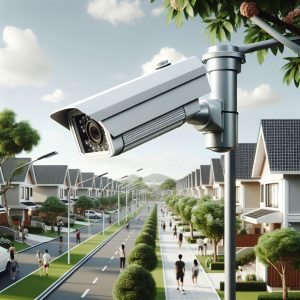Choosing a professional security system is a significant step toward enhancing home safety. Unlike DIY setups, professionally installed systems are handled by skilled technicians who assess your property, install equipment, and ensure everything is functioning correctly. For homeowners new to professional installations, understanding the process can help set expectations and make the experience smooth and straightforward. This guide walks you through each stage of a professional security system installation, from the initial consultation to ongoing maintenance.
1. The Initial Consultation and Security Assessment
The process starts with an initial consultation and security assessment. During this stage, a security expert visits your home to evaluate the property, identify potential vulnerabilities, and discuss your specific needs and preferences.
What to Expect:
- Property Walkthrough: The technician will examine entry points, windows, and outdoor areas to determine where security devices should be installed.
- Customized Recommendations: Based on your home’s layout and any existing security measures, the technician will design a custom security plan that may include cameras, sensors, alarms, and environmental sensors for fire or carbon monoxide detection.
- Budget Discussion: Your budget is considered, with options to tailor the system to your needs. Many companies offer flexible packages and financing options for comprehensive coverage within your budget.
- Scheduling the Installation: Once you agree on the security plan, you’ll schedule the installation, which may take place immediately or within a few days, depending on the provider.
The consultation is an excellent opportunity to ask about monitoring options, additional services, and any other questions related to your system.
2. Choosing the Right Components for Your Security System
Professional systems offer a variety of components that can be tailored to your home’s unique needs. The technician will help you select the devices that best suit your layout, security requirements, and lifestyle.
Common Security Components:
- Control Panel: The system’s central hub where you can arm and disarm the system, access notifications, and control other devices. Control panels are typically installed near the main entrance.
- Security Cameras: Cameras can be placed indoors or outdoors to monitor areas like entryways, driveways, and backyards. Many systems feature HD cameras with night vision and motion detection.
- Motion Sensors and Door/Window Sensors: These detect movement and can trigger an alarm if unexpected activity occurs, especially at entry points and high-traffic areas.
- Environmental Sensors: Smoke, carbon monoxide, and water leak detectors protect against non-intrusion threats, offering additional peace of mind.
- Smart Home Integration: Some systems integrate with smart home devices, allowing you to control lights, locks, and thermostats through a single platform.
3. System Installation Process
On installation day, the technician will arrive to set up the system. The installation can take anywhere from a couple of hours to a full day, depending on the size and complexity of your setup.
Installation Steps:
- Mounting Cameras and Sensors: The technician installs cameras, sensors, and other devices in strategic locations identified during the assessment. They ensure that each device is optimally placed for maximum coverage.
- Setting Up the Control Panel: The control panel is configured to communicate with all devices, ensuring synchronization across alarms, sensors, and cameras.
- Connecting to Power and Wi-Fi: Security devices are either hardwired or connected to Wi-Fi. Hardwired systems involve wiring through walls, while wireless devices connect quickly to your Wi-Fi network.
- Configuring Smart Home Devices: If you’ve chosen smart home integration, the technician will link compatible devices to your security system for seamless control.
During installation, each device is tested to confirm that it’s working correctly. The technician may test cameras, sensors, and alarms to ensure they’re responding accurately.
4. Testing and Calibration
After installation, the technician thoroughly tests each device to confirm that everything functions as expected. This testing phase is crucial for ensuring reliable performance.
Testing Process:
- Alarm and Sensor Testing: The technician triggers alarms and sensors to verify they detect movement or activity correctly.
- Camera Feed Check: Camera feeds are reviewed to ensure image clarity and proper coverage of intended areas. The technician also confirms you can access these feeds from your smartphone or control panel.
- System Notifications: Different alerts (e.g., motion detected, door opened) are simulated to ensure you receive real-time notifications on your selected devices.
If adjustments are needed, the technician will calibrate devices for accuracy, ensuring a smooth and reliable operation.
5. Walkthrough and User Training
Once the system is installed and tested, the technician will provide a thorough walkthrough and training session on using the system. This hands-on session helps you become familiar with operating and maintaining your security setup.
What the Walkthrough Includes:
- Control Panel Functions: Learn to arm/disarm the system, use emergency buttons, and adjust settings. You’ll also learn how to access the system remotely through an app if available.
- Accessing Camera Feeds and Notifications: You’ll be shown how to view live feeds, review recorded footage, and adjust notification settings.
- Setting Up User Codes: For systems with smart locks, the technician can help set up unique access codes for family members, guests, or trusted individuals.
- Maintenance Tips: The technician provides maintenance advice, including checking sensors, replacing batteries, and handling basic troubleshooting.
This session is a valuable chance to ask final questions and make sure you’re comfortable using the system.
6. Professional Monitoring Services (Optional)
Many security providers offer professional monitoring services for an added monthly fee. With professional monitoring, a monitoring center receives alerts when an alarm is triggered and can quickly notify emergency services on your behalf.
Benefits of Professional Monitoring:
- 24/7 Monitoring: Professional teams are available around the clock, ensuring your home is monitored even when you’re away.
- Rapid Emergency Response: If a break-in, fire, or other emergency is detected, the monitoring center can dispatch police, fire, or medical services.
- False Alarm Management: Monitoring centers can verify alarms before contacting emergency responders, helping reduce false alarms.
Professional monitoring provides peace of mind, especially for those who travel frequently or cannot always respond to alerts themselves.
7. Maintenance and Ongoing Support
Most security companies offer ongoing support and maintenance options to keep your system fully operational. Regular maintenance helps identify and address issues early, preventing interruptions in service.
Ongoing Maintenance Tips:
- Scheduled Maintenance Visits: Many companies offer periodic maintenance visits to check devices, replace batteries, and update system software.
- Remote Diagnostics: Some providers can perform remote diagnostics on your system, identifying and fixing issues without an in-person visit.
- Customer Support: Most companies provide phone or online support for troubleshooting and technical assistance.
Staying proactive with maintenance ensures your system remains reliable, providing long-term security without unnecessary disruptions.
Conclusion
Investing in a professionally installed security system offers a reliable, comprehensive approach to home protection. From the initial consultation to final testing and training, each step is designed to tailor the system to your needs and ensure smooth operation. With options for professional monitoring, regular maintenance, and ongoing support, you gain the peace of mind that comes with expert oversight and support.
Whether you’re upgrading from a DIY system or setting up your first professional security solution, understanding the installation process can help you create a secure, user-friendly system tailored to your home.





